Chapter 6: Principles of Forensic Evidence Collection and Preservation
Evidence Sources and the Environment
- Locard's principle
- This principle states that physical evidence can be used to corroborate or disprove a person's recollection of events, implicate a person to the commission of a crime, or exonerate those wrongly suspected or accused of committing a crime.
- Physical evidence is an invaluable tool for law enforcement authorities, but its integrity must be upheld through careful handling, proper collection, and a documented chain of custody.
- Chain of custody
- Chain-of-custody documents record the link formed between each person who handles a piece of evidence.
- It is best to use chain-of-custody forms designated by the organization for whom one works.
- Once an evidence container is selected, it must be marked for identification.
- If the evidence is turned over to another individual for care or delivery to the laboratory, this transfer must be recorded in notes and on other appropriate forms.
- Every individual who has occasion to possess the evidence must maintain a written record of its acquisition and disposition.
- To avoid confusion and to retain complete control of the evidence, the chain of custody should be kept to a minimum.
Documentation of Evidence
Photodocumentation
- Digital photography is made when a light-sensitive microchip inside the camera is exposed to light coming from the object or scene.
- SLR and DSLR cameras allow for the use of a wide range of lenses, flashes, and filters, as well as the option of manually selecting f-stop, shutter speed, and other variables.
- Digital photography is rapidly becoming the method of choice in the field of forensic science, but it can be easily manipulated by computer software.
- The main purpose of forensic photography is to %%provide an accurate depiction%%.
- To ensure that digital images are admissible, jurisdictions set guidelines and enforce strict protocols for image security and chain of custody.
- Photographs of the patient should include the face, injured areas, and a photo log. An object of measurement should be included to delineate the size of the injury.
- As the condition of the injured area changes, subsequent photographs should be taken to reflect such changes. Handwritten notes should also be taken.
Anatomical charts and diagrams
- An anatomical chart should be used to record all marks on the body, including size, shape, color, location, and foreign material.
- Emergency department personnel should also be recorded, as well as verbal statements made by the patient.
- An inventory list should be maintained.
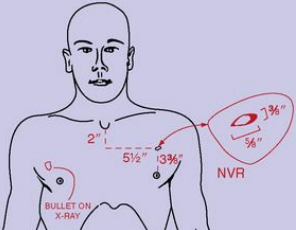
Evidence Kits
Commercial evidence collection kits are a convenient and useful means for assuring the availability of appropriate evidence containers.
Commercial evidence containers will also have appropriate chain of custody information printed on the outside of the container.
The kit normally includes a variety of small metal cans for the collection of debris, paint chips, glass particles, or metal fragments.
Paper envelopes of different sizes are present to package bullets, cartridge cases, or hairs and fibers.
Zipper-locked plastic bags provide packaging for soil samples, drugs, or dried plant materials. Evidence seals are an important component of the kit.
They allow for the sealing of the various containers within the kit so that evidence tampering is not possible.
Any attempt to gain access to the container will require the obvious breaking and disruption of the seal
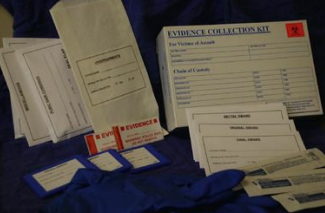
Evidence on Clothing
The recognition of physical evidence is not always an easy task, but by learning to recognize where and how such exchanges take place, emergency room personnel can aid in the collection and preservation of potential forensic evidence.
For example, when a bullet penetrates a piece of clothing, characteristic material is usually deposited on the garment.
Partially burned and unburned gunpowder particles can be scattered around the bullet hole, revealing information about the distance between the firearm and the victim.
Even in situations where no gunpowder residue is deposited on the garment, important information can be obtained from a dark ring, known as bullet wipe, surrounding the bullet hole.
This ring is composed of material transferred from the surface of the bullet onto the target as the bullet passes through the fabric.
The most important details in this text are the evidence retrieved from bullet holes in clothing, rip patterns caused by a penetrating bullet, and cuts in clothing arising from sharp objects such as a knife blade.
The removal of clothing from a patient must be performed in a careful and conscientious manner, cutting along seams and away from the injured area.
If the patient is dead on arrival or dying while in the emergency room, all clothing, including the shoes and any linen in contact with the patient, should be kept with the body when it is turned over to the medical examiner.
If transportation may lead to loss of evidence, the medical professional should properly collect and package those materials.
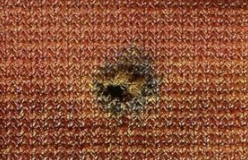
Preservation of Clothing-Related Evidence
Crimes involving the contact of a victim with another person or object are particularly fertile for the retrieval of physical evidence.
The clothing of the victim of a hit-and-run incident is a focus of attention due to the blunt force placed on the body by a vehicle.
Paint chips and debris can also dislodge during this type of accident, so any found items should be documented in detail, properly packaged, and labeled.
Paint chips can be picked up with a tweezers or scooped up with a piece of paper.
Paper druggist folds and glass or plastic vials make excellent containers for paint.
The investigator should not attempt to remove paint from garments or objects, but rather package them carefully and send them to the laboratory for examination.
If any article is wet or damp, the healthcare technician should air-dry it in a secured area.
Clothing should never be placed in plastic bags, and paper should be placed between any materials that must be folded against each other.
Each bag containing a piece of clothing should be labeled with pertinent information, including a detailed description of its contents, the patient's name, the name of the person who collected the evidence, and the date and time the evidence was collected.
Additionally, persons involved with a shooting should have their hands placed in paper bags and sealed with tape to the wrist to prevent the loss of primer residue.
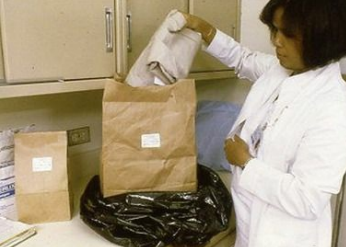
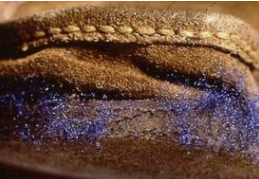
Preservation of Firearm Evidence
- Bullets, cartridge casings, and other types of debris such as glass or metal fragments are sometimes found near or within a patient admitted into an emergency room.
- All such evidence is fragile, and necessary precautions need to be taken to ensure all original conditions remain intact as much as possible.
- When bullets and other types of debris are collected, rubber-tipped forceps or gloved hands should be utilized.
- Recommended packaging for this type of evidence includes manilaclasped envelopes or zipper-locked plastic bags for each piece collected.
Other Physical and Trace Evidence
- Glass fragments
- Gathering glass evidence must be thorough and include broken parts of headlights and reflectors.
- Shoes and clothing should be individually wrapped in paper and transmitted to the laboratory, unless necessary for preservation.
- Soil
- Soil found on a victim or suspect should be carefully preserved for analysis.
- It should not be removed, but wrapped in paper bags and sent to the laboratory.
- When a lump of soil is found, it should be collected and preserved intact, as this form imparts greater evidential value.
- Hair
- When questioned hairs are submitted to a forensic laboratory for examination, they must be accompanied by an adequate number of control samples from the victim of the crime and from individuals suspected of having deposited hair at the crime scene.
- Control samples must come from the same area of the body as the questioned hairs, and the collection of control hair must be carried out in a way to ensure a representative sampling of hair from any one area of the body.
- In rape cases, care must be taken to comb the pubic area with a clean comb before the victim is sampled for control hair.
- Current laboratory protocols for conducting hair comparisons do not require that hair roots be associated with hair controls exemplars.
- Fiber
- Fiber evidence can be associated with any type of crime, so it must be identified and preserved.
- Articles of clothing must be packaged in separate bags to avoid cross-contamination.
- Adhesive tape lifts of exposed body areas may reveal fiber strands on examination.
- Arson evidence
- Arson investigators must consider the clothing of the suspect perpetrator when investigating the crime of arson.
- The forensic laboratory can detect extremely small quantities of accelerant materials, making the examination of the clothing a feasible approach.
- Each item of clothing should be placed in an airtight container, preferably a new, clean paint can, as they are airtight, unbreakable, and nonreactive with volatile hydrocarbons.
- Sexual assault evidence
- The presence of seminal constituents in a rape victim is important evidence, but physical injuries such as bruises or bleeding can also confirm a violent assault.
- To protect physical evidence, all outer- and undergarments from the involved parties should be carefully removed and packaged separately in paper bags.
- If the victim can stand to disrobe, precautions should be taken, such as placing a clean bed sheet on the floor and a paper sheet over it.
- The most important details are that items suspected of containing seminal stains must be handled carefully, and that all body fluids and biologically stained materials must be assumed to be infectious.
- Evidence collectors must wear disposable latex gloves while handling the evidence, and trained personnel must collect the appropriate items of physical evidence.
Physical Evidence Collected from Rape Victims
- Pubic combings
- Place a paper towel under the buttocks
- Then, comb pubic area for loose or foreign hairs.
- Pubic hair controls
- Clip two dozen full-length hairs from the pubic area, close to the skin line.
- External-genital swabs.
- Carefully swab the genital area and inner thighs with two lightly moistened swabs.
- After the collection is made, the swab must be air-dried for approximately 5 to 10 minutes, then is best placed in a swab box.
- The swab box has a circular hole, which allows for air circulation.
- The swab box can then be placed in a paper or manila container.
- Vaginal swabs and smear
- Using two swabs simultaneously, carefully swab the vaginal area and let the swabs air-dry before packaging.
- Using two additional swabs, repeat the swabbing procedure, and smear the swabs onto separate microscope slides, allowing them to air-dry before packaging in a swab box.
- One point is critical: the collected swabs must not be packaged in a wet state.
- Cervix swabs
- Using two swabs simultaneously, carefully swab the cervix area
- And let the swabs air-dry before packaging.
- Rectal swabs and smear
- To be taken when warranted by case history.
- Before taking rectal swabs, carefully swab the perianal area with two lightly moistened swabs to prevent contamination of the rectal swabs from vaginal fluid drainage that may be present on the anus.
- Then using two swabs simultaneously, swab the rectal canal, smearing one of the swabs onto a microscope slide. Allow both samples to air-dry before packaging in a swab box.
- Oral swabs and smear
- To be taken if oral-genital contact occurred.
- Use two swabs simultaneously to swab the buccal area and gum line.
- Using both swabs, prepare one smear slide.
- Allow both swabs and the one smear to air-dry before packaging in a swab box.
- Head hairs
- Clip at the skin line a minimum of five full-length hairs from each of the following scalp locations: center, front, back, left side, and right side.
- It is recommended that a total of at least 50 hairs be clipped and submitted to the laboratory.
- Blood sample
- The blood sample should be collected in a sterile vacuum tube containing the preservative ethylenediamine tetraacetic acid (EDTA).
- EDTA inhibits the activity of enzymes that act to degrade DNA.
- The blood sample can be used for DNA typing, as well as for toxicological analysis if it is required.
- The tubes must be kept refrigerated (do not freeze) while awaiting transportation to the laboratory.
- Besides blood, there are other options for obtaining control DNA specimens.
- The least intrusive DNA control and one that can readily be used by nonmedical personnel is the buccal swab.
- Here, cotton swabs are placed in the subject's mouth, and the inside of the cheek is vigorously swabbed, resulting in the transfer of buccal cells onto the swab
- Fingernail scrapings
- Scrape the undersurface of the nails with a dull object over a piece of clean paper to collect debris.
- Use separate paper, one for each hand.
- Urine specimen
- Thirty milliliters or more of urine should be collected from the victim for the purpose of conducting a drug toxicological analysis for alcohol and drugs.